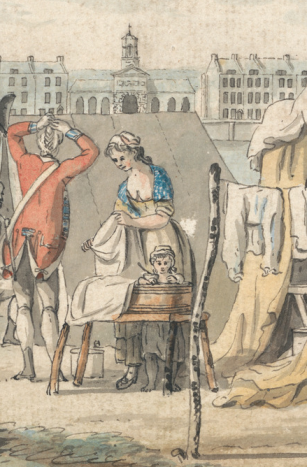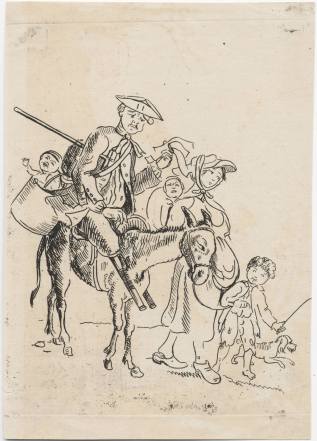Tags
10th Massachusetts, 18th century, Brigade of the American Revolution, common people, common soldier, Continental Army, genealogy, impressions, laundry, living history, orderly books, Research

Detail, James Malton, A Military Encampment in Hyde Park, 1785. YCBA Paul Mellon Collection. B2001.2.999
Who knows? She’s hard to find, though I am told and have real hope that the microfilm of the Abbott orderly books that chronicle her misdeeds in wending its way to me down the dirty, salt-and-sand covered highways of southeastern New England.
Where have I looked for her and Francis Connor, whom I presume is her husband?
- In every online vital record for the Commonwealth of Massachusetts.
- In the National Archives microfilm of compiled records of Massachusetts soldiers in the 10th Regiment and the miscellaneous records.
- In the Revolutionary War pension records index.
- In the DAR index.
- In the Soldiers and Sailors of Massachusetts.
Francis appears in Soldiers and Sailors of Massachusetts, for seven months’ service. That’s all I can find.
Well, crap, right? This genealogy stuff in Massachusetts is hard work—there are so many more people and towns than we have here in Li’l Rhody—but diligence and method pay off, and when you figure you’ve about exhausted the primary sources you can access for now,[1] you turn to secondary sources.
Lest you think I dislike Deborah Samson, note that I found her life a useful source in thinking about Bridget, as well as Book of Ages and Jane Franklin Mecom’s life. I’ve also been re-reading Holly Mayer’s Belonging to the Army.
The common denominator: poverty, and the resulting lack of choices. This is useful for Bridget, because her story is probably one of necessity. Most women who followed the Continental Army, and worked for it, were from the lowest ranks. [2] These are women who would do what was necessary to survive, and as Mayer notes, “would rather steal than starve.” [3]
I’m not suggesting that Bridget, who would likely have received rations, needed to steal shirts to survive: I rather think she was attempting to leverage her position and profit by ill-gotten gains. But how did she end up in the Army to begin with? Massachusetts in 1782 is not New York in 1780, or Rhode Island in 1778. What drove her to (presumably) follow Francis Connor?
Late in the war, maintaining troop strength is more difficult. The fervor of patriotism has cooled, and recruiting sergeants find it harder to fill the ranks.[4] There are bounties to be had, and the economy has suffered. Could Francis have been a property-less laborer who enlisted for the bounty? Nothing talks like cash. And, if the couple were tenants somewhere, without Francis’ income, Bridget might not have been able to maintain a home. Laundry doesn’t pay that much.
Why didn’t she stay with family? Could they have been indentured servants? Could they have been immigrants? My guess is that Bridget had no family, and if Francis had family, Bridget got on with them as well as she did with the officers of the 10th. I think she had nowhere to go, no way to survive without Francis.
Did they love each other? Did they like each other? Were they grifting together? I don’t know—but Francis Connor deserts the same day Bridget Connor is expelled from camp, so they’re bound together in some way. No matter what, Bridget was assuredly dependent on Francis.
Knowing so little about them opens up a world of possibilities, and the “opportunity” to do a great deal more research on the context of 18th century Massachusetts populations and enlistments. My best guess is that they’re an unpropertied laboring class couple from Boston, source of many of the relatively unstable and non-homogenous companies that made up the 10th Massachusetts. I also think they don’t have family, and might be former indentured servants. I have guesses about their religion and country of origin, which could be why the records are so hard to find. [5]
Looking for Bridget, and not finding her, leaves me with more and more questions, and I’m happy about that.
[1] She’s in the Abbott Orderly books, at least. Other Orderly Books to follow, as time and funds permit.
[2] Mayer, Belonging to the Army, page 122.
[3] Mayer, page 127
[4] How do you think Deborah Samson got in, passing as a boy? That’s 1782 for you.
[5] The Catholic Diocese of Rhode Island maintains separate historical vital records, and when we cannot find someone in the usual town records, we ask the genealogist if their family is perhaps Catholic or Quaker. Lack of evidence can be a suggestion of faith in my home state. But could these two be Irish Catholic in Massachusetts in 1782? I have no idea, but it seems a great stretch and a great question all at once.


There certainly were irish in Massachusetts in the revolutionary era. I would check with the Charitable Irish Society in Boston that was started in 1737. Irish Catholics although a small part of the population of the colonies were some of the most fervent for the cause of liberty.
Thanks for the tip! it’s so helpful to know where to start!
Pingback: The Shurts off there Backs | Kitty Calash
Pingback: Feminism and Following – 17th
Do you know for sure they were a couple? Could they have been brother and sister? If so, She could have changed names. This would also explain why he left when she did.